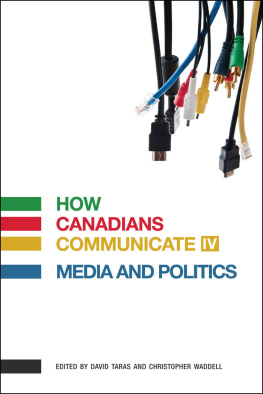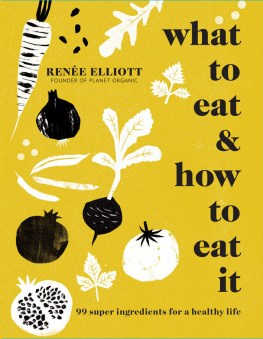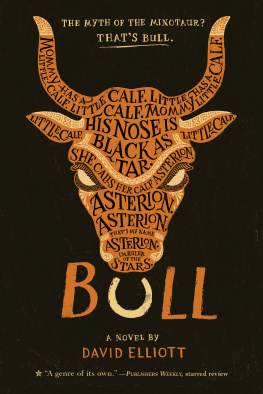How Canadians Communicate VI
How Canadians Communicate VI
FOOD PROMOTION, CONSUMPTION, AND CONTROVERSY
Edited by Charlene Elliott
Copyright 2016 Charlene Elliott
Published by AU Press, Athabasca University
1200, 10011 109 Street, Edmonton, AB T5J 3S8
ISBN 978-1-77199-025-7 (pbk.) 978-1-77199-026-4 (PDF) 978-1-77199-027-1 (epub)
doi: 10.15215/aupress/9781771990257.01
Cover design by Natalie Olsen, Kisscut Design
Interior design by Sergiy Kozakov
Printed and bound in Canada by Friesens
Library and Archives Canada Cataloguing in Publication
Food promotion, consumption, and controversy / edited by Charlene Elliott.
(How Canadians communicate ; VI)
Includes bibliographical references and index.
Issued in print and electronic formats.
1. Food habitsCanada. 2. FoodSocial aspectsCanada. 3. FoodCanadaMarketing. 4. Food consumptionCanada. 5. Food law and legislationCanada. 6. Communication and cultureCanada. I. Elliott, Charlene, author, editor II. Series: How Canadians communicate (Series) ; 6
GT2853.C3F72 2016 394.1'20971 C2015-906045-1
C2015-906046-X
We acknowledge the financial support of the Government of Canada through the Canada Book Fund (CFB) for our publishing activities.
Assistance provided by the Government of Alberta, Alberta Media Fund.
Please contact AU Press, Athabasca University at for permissions and copyright information.
The following images used on the book jacket are courtesy of Shutterstock.com:
Image ID: 254748145 diamant24 / Shutterstock.com
Image ID: 163030034 Vladimir Shulenin / Shutterstock.com
Image ID: 94284883 Shelby Allison / Shutterstock.com
Image ID: 149271665 Pinkcandy / Shutterstock.com
Contents
Charlene Elliott
Charlene Elliott and Wayne McCready
Jordan LeBel
Valerie Tarasuk
Eric Pateman and Shannon King
Ken Albala
Jacqueline Botterill
Nathalie Cooke
Irina D. Mihalache
Elizabeth Baird
John Gilchrist
Catherine Carstairs, Paige Schell, and Sheilagh Quaile
Melanie Rock
Rebecca Carruthers Den Hoed
Pierre Desrochers
Charlene Elliott and Josh Greenberg
Stephen Kline
Harvey Levenstein
Acknowledgements
This book is the result of a collaborative effort between the Alberta Global Form (AGF), based at Mount Royal University, and the University of Calgary, Carleton University, and Athabasca University. I am especially grateful to David Taras, who established the How Canadians Communicate series and graciously provided me with the opportunity to envision and realize a volume on the topic of food. I would also like to thank the members of the AGF board, who offered ideas and feedback at the formative stages of this project.
The conference that gave rise to this book received support from various entities. Along with contributions from the universities listed above, generous support was provided by the Canada Research Chairs program, Glacier Media (special thanks to Bill Whitelaw), and Alberta business and community leader Allan Markin. Restaurant reviewer John Gilchrist and Donald House, of Integrated Digital Media Group, Inc., were especially generous with their time and ideas, for which I am most grateful.
Pamela MacFarland Holway of Athabasca University Press provided support and constructive feedback on the volume. Rebecca Carruthers Den Hoed did an excellent job in preparing the manuscript, and was a genuine pleasure to work with. Wayne McCready deserves special mention, not only for his support in the role of director of the Calgary Institute for the Humanities but also for his time, feedback, and friendship throughout.
Quite apart from the stellar participation of the books contributors, other individuals were instrumental in making the conference event a success: Claire Cummings brought her expertise in organizing the conference, and Corinne McKetiak designed the conference logo and promotional materials. For the kickoff event, warmest thanks go to Canadas Top Chefs, John Jackson and Connie DeSousa, Xavier Lacaze, and Geoff Rogers; the Calgary Farmers Market; and Mount Royal Universitys Greg Ruhl and his Information Design students.
Above all, I would like to thank Tannis Baker, whose ideas, creativity and contributions worked to make the conferenceand subsequent volumea success.
How Canadians Communicate VIIntroduction
Charlene Elliott
Tell me what thou eatest, and I will tell thee what thou art.
Jean Anthelme Brillat-Savarin
To begin a book on food with Brillat-Savarins most famous aphorism has become a clich. As the American journalist Bill Buford observes, the idea that you are what you eat has been repeated so relentlessly that it is now a modern advertising banality (2009, viii). Certainly, Brillat-Savarin offers other pithy insights to choose from in his Physiologie du got, including such claims as the destiny of nations depends on how they nourish themselves and the discovery of a new dish does more for human happiness than the discovery of a star (Brillat-Savarin [1825] 1884, 15, 16). Yet despite aphorisms that tackle such grand themes as national destiny and human happiness, it is his comment on food and identity that steals the limelight: Tell me what thou eatest, and I will tell thee what thou art.
As a communication scholar, I am interested less in the identity than in the telling, less intrigued by the you are what you eat than by the communication through and about food. Brillat-Savarins tell me what thou eatest captures the representation, expression, and language of food; his I will tell thee what thou art captures the evaluative component of this representation. The phrase as a whole suggests a dialogue, an interactive exchange around food thatwhile bound up with normative judgmentsis less final than it sounds. It is difficult to imagine that being told what thou art would put an end to the conversation. One would imagine, instead, that this would be a starting point for debate.
Conversations and debates about food form the basis of this volume. How Canadians Communicate VI: Food Promotion, Consumption, and Controversy brings together a range of scholars and experts who examine important questions about food and communication. Here, we are interested in how food is represented (in terms of advertising, promotion, food journalism, food radio, and food television), how it is regulated (via policy and law, foodways, and food systems), how it is consumed (consumer perceptions and attitudes, Canadian habits of consumption, and so on), and how it figures in various controversies (from debates over pasteurization to responses to contaminated food scares). In tackling broad issues of promotion, policy, consumption, and controversy, we hope to illuminateand troublesome important aspects of the contemporary food landscape.














